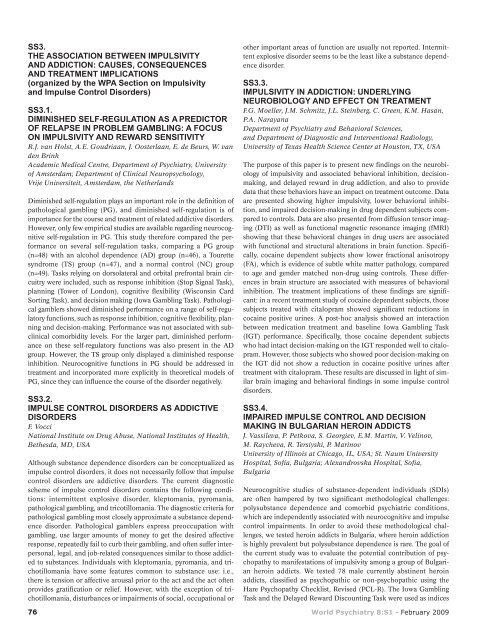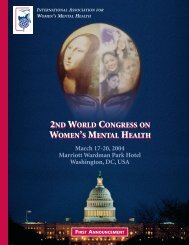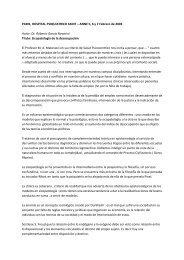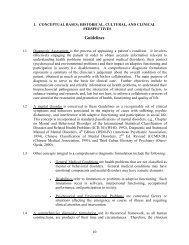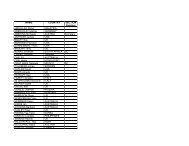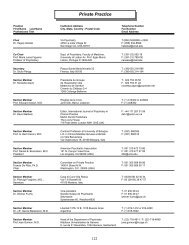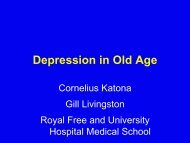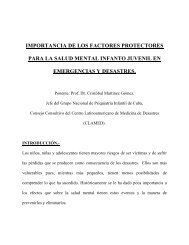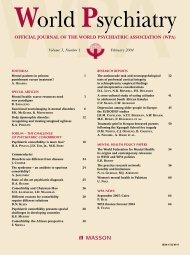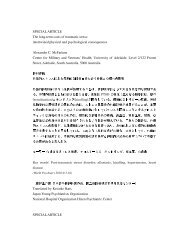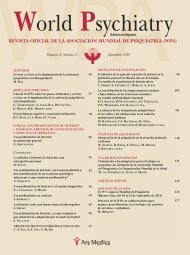ABSTRACTS - World Psychiatric Association
ABSTRACTS - World Psychiatric Association
ABSTRACTS - World Psychiatric Association
Create successful ePaper yourself
Turn your PDF publications into a flip-book with our unique Google optimized e-Paper software.
SS3.<br />
THE ASSOCIATION BETWEEN IMPULSIVITY<br />
AND ADDICTION: CAUSES, CONSEQUENCES<br />
AND TREATMENT IMPLICATIONS<br />
(organized by the WPA Section on Impulsivity<br />
and Impulse Control Disorders)<br />
SS3.1.<br />
DIMINISHED SELF-REGULATION AS A PREDICTOR<br />
OF RELAPSE IN PROBLEM GAMBLING: A FOCUS<br />
ON IMPULSIVITY AND REWARD SENSITIVITY<br />
R.J. van Holst, A.E. Goudriaan, J. Oosterlaan, E. de Beurs, W. van<br />
den Brink<br />
Academic Medical Centre, Department of Psychiatry, University<br />
of Amsterdam; Department of Clinical Neuropsychology,<br />
Vrije Universiteit, Amsterdam, the Netherlands<br />
Diminished self-regulation plays an important role in the definition of<br />
pathological gambling (PG), and diminished self-regulation is of<br />
importance for the course and treatment of related addictive disorders.<br />
However, only few empirical studies are available regarding neurocognitive<br />
self-regulation in PG. This study therefore compared the performance<br />
on several self-regulation tasks, comparing a PG group<br />
(n=48) with an alcohol dependence (AD) group (n=46), a Tourette<br />
syndrome (TS) group (n=47), and a normal control (NC) group<br />
(n=49). Tasks relying on dorsolateral and orbital prefrontal brain circuitry<br />
were included, such as response inhibition (Stop Signal Task),<br />
planning (Tower of London), cognitive flexibility (Wisconsin Card<br />
Sorting Task), and decision making (Iowa Gambling Task). Pathological<br />
gamblers showed diminished performance on a range of self-regulatory<br />
functions, such as response inhibition, cognitive flexibility, planning<br />
and decision-making. Performance was not associated with subclinical<br />
comorbidity levels. For the larger part, diminished performance<br />
on these self-regulatory functions was also present in the AD<br />
group. However, the TS group only displayed a diminished response<br />
inhibition. Neurocognitive functions in PG should be addressed in<br />
treatment and incorporated more explicitly in theoretical models of<br />
PG, since they can influence the course of the disorder negatively.<br />
SS3.2.<br />
IMPULSE CONTROL DISORDERS AS ADDICTIVE<br />
DISORDERS<br />
F. Vocci<br />
National Institute on Drug Abuse, National Institutes of Health,<br />
Bethesda, MD, USA<br />
Although substance dependence disorders can be conceptualized as<br />
impulse control disorders, it does not necessarily follow that impulse<br />
control disorders are addictive disorders. The current diagnostic<br />
scheme of impulse control disorders contains the following conditions:<br />
intermittent explosive disorder, kleptomania, pyromania,<br />
pathological gambling, and tricotillomania. The diagnostic criteria for<br />
pathological gambling most closely approximate a substance dependence<br />
disorder. Pathological gamblers express preoccupation with<br />
gambling, use larger amounts of money to get the desired affective<br />
response, repeatedly fail to curb their gambling, and often suffer interpersonal,<br />
legal, and job-related consequences similar to those addicted<br />
to substances. Individuals with kleptomania, pyromania, and trichotillomania<br />
have some features common to substance use: i.e.,<br />
there is tension or affective arousal prior to the act and the act often<br />
provides gratification or relief. However, with the exception of trichotillomania,<br />
disturbances or impairments of social, occupational or<br />
other important areas of function are usually not reported. Intermittent<br />
explosive disorder seems to be the least like a substance dependence<br />
disorder.<br />
SS3.3.<br />
IMPULSIVITY IN ADDICTION: UNDERLYING<br />
NEUROBIOLOGY AND EFFECT ON TREATMENT<br />
F.G. Moeller, J.M. Schmitz, J.L. Steinberg, C. Green, K.M. Hasan,<br />
P.A. Narayana<br />
Department of Psychiatry and Behavioral Sciences,<br />
and Department of Diagnostic and Interventional Radiology,<br />
University of Texas Health Science Center at Houston, TX, USA<br />
The purpose of this paper is to present new findings on the neurobiology<br />
of impulsivity and associated behavioral inhibition, decisionmaking,<br />
and delayed reward in drug addiction, and also to provide<br />
data that these behaviors have an impact on treatment outcome. Data<br />
are presented showing higher impulsivity, lower behavioral inhibition,<br />
and impaired decision-making in drug dependent subjects compared<br />
to controls. Data are also presented from diffusion tensor imaging<br />
(DTI) as well as functional magnetic resonance imaging (fMRI)<br />
showing that these behavioral changes in drug users are associated<br />
with functional and structural alterations in brain function. Specifically,<br />
cocaine dependent subjects show lower fractional anisotropy<br />
(FA), which is evidence of subtle white matter pathology, compared<br />
to age and gender matched non-drug using controls. These differences<br />
in brain structure are associated with measures of behavioral<br />
inhibition. The treatment implications of these findings are significant:<br />
in a recent treatment study of cocaine dependent subjects, those<br />
subjects treated with citalopram showed significant reductions in<br />
cocaine positive urines. A post-hoc analysis showed an interaction<br />
between medication treatment and baseline Iowa Gambling Task<br />
(IGT) performance. Specifically, those cocaine dependent subjects<br />
who had intact decision-making on the IGT responded well to citalopram.<br />
However, those subjects who showed poor decision-making on<br />
the IGT did not show a reduction in cocaine positive urines after<br />
treatment with citalopram. These results are discussed in light of similar<br />
brain imaging and behavioral findings in some impulse control<br />
disorders.<br />
SS3.4.<br />
IMPAIRED IMPULSE CONTROL AND DECISION<br />
MAKING IN BULGARIAN HEROIN ADDICTS<br />
J. Vassileva, P. Petkova, S. Georgiev, E.M. Martin, V. Velinov,<br />
M. Raycheva, R. Tersiyski, P. Marinov<br />
University of Illinois at Chicago, IL, USA; St. Naum University<br />
Hospital, Sofia, Bulgaria; Alexandrovska Hospital, Sofia,<br />
Bulgaria<br />
Neurocognitive studies of substance-dependent individuals (SDIs)<br />
are often hampered by two significant methodological challenges:<br />
polysubstance dependence and comorbid psychiatric conditions,<br />
which are independently associated with neurocognitive and impulse<br />
control impairments. In order to avoid these methodological challenges,<br />
we tested heroin addicts in Bulgaria, where heroin addiction<br />
is highly prevalent but polysubstance dependence is rare. The goal of<br />
the current study was to evaluate the potential contribution of psychopathy<br />
to manifestations of impulsivity among a group of Bulgarian<br />
heroin addicts. We tested 78 male currently abstinent heroin<br />
addicts, classified as psychopathic or non-psychopathic using the<br />
Hare Psychopathy Checklist, Revised (PCL-R). The Iowa Gambling<br />
Task and the Delayed Reward Discounting Task were used as indices<br />
76 <strong>World</strong> Psychiatry 8:S1 - February 2009


